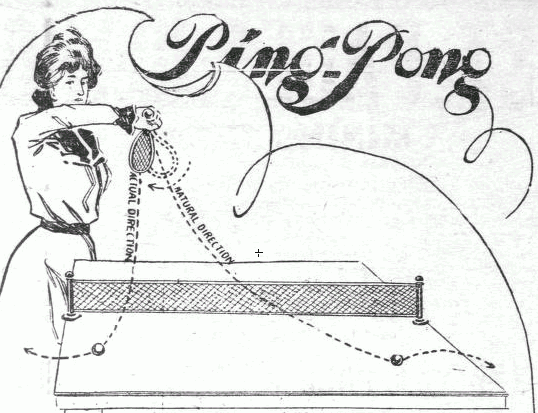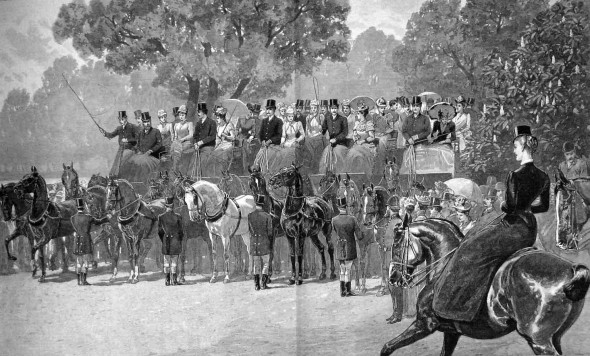During the late Victorian and Edwardian eras, the convergence of time-saving technologies, increased prosperity, and the growing middle- and leisure-classes created a society ripe for a variety of fads. One of these fads was for ping-pong, or table tennis. Lawn tennis, the outdoor sport, rose in popularity in the 1870s and 1880s, and no doubt due to the vagaries of English weather, the tennis-mad devised a way to play the sport indoors. This indoor tennis game, known as “whiff-whaff” or, according to famed toy shop Hamley’s of Regent Street, as “Gossima,” gradually became a popular after-dinner parlour game until around 1901 when The Windsor Magazine stated “whilst the game was undoubtedly introduced in a crude form several years ago, it was not played to any extent till July or August of last year, yet by Christmas it had caused a perfect furore, and no upper or middle class social function was considered complete without its Ping Pong table.”

“Arnold Parker, the author of Ping-Pong, the Game and How to Play It, 1902, and one of the earliest champions, gives 1881 as the first date he had heard in connection with the game. He says that there was a rumour that someone in that year started to play with cigar-box lids for bats, champagne corks (rounded one assumes) for balls and a row of books for a net. This is rather vague but he states more confidently that the game really began about 1891 when a Mr. James Gibb persuaded John Jaques, the sports manufacturers, to register the title ‘Gossima’ for a version of the game which first of all used india-rubber balls until the introduction, about 1900, of celluloid (or xylonite) balls. The much repeated story – which probably originates with Parker – tells how Gibb, a prominent athlete, brought back some toy celluloid halls (sometimes said to be coloured) from the United States. Jaques soon saw how these balls were a huge improvement on the small india-rubber balls previously used” [Source]
Jaques of London trademarked the word “ping pong” in 1901, and the name “came to be used for the game played by the rather expensive Jaquesses equipment, with other manufacturers calling it table tennis.” By the following year, fifteen books were published on the topic and the craze had spread to the United States, where, according to The Suburban Citizen, thousands of sets were sold, and one factory even churned out 1000 sets daily.
Ping-pong even infiltrated America’s golf clubs:
“Our indoor putting green in the back of the store has been occupied by a ping-pong table for several weeks. Lots of people who never saw the game come in here and watch a few sets, get fascinated by the play and end by buying racquets and balls and a net to take home and set up on their dining-room or billiard table. There’s a game going on here almost every hour of the day. People can’t seem to get enough of it.”
The activity acquired legitimacy through its recommended health benefits, and Zaza Belasco (surely a pseudonym!) states confidently in Woman’s Physical Development:
Ping pong makes you work hard. Ping pong causes rills and rivulets of perspiration to flow and makes you feel from head to foot that moist glow that only hard exercise can produce. There is no doubt that it is one of the best flesh reducers known to too heavy man—or woman.
According to Dr. F. L. Burt of the Union General Hospital of Boston, and a well-known specialist: ” Proud men and beautiful women spend at least $1,000,000 every year in Boston alone, and nobody knows how many millions of foot pounds of energy, in their frantic efforts to get rid of superfluous tissue. They ride, swim, walk, box, fence, play golf, and do all sorts of leg-swinging and kicking up calisthenics in their anxiety to get thin and stay so. They enrich doctors who have the reputation of being able to cure adiposity. Quacks of all kinds thrive and fatten on these martyrs who drink nauseous waters, hot or lukewarm, and who submit to boiling, steaming, baking and Japanese, Burmese, Swedish or German massage in the hope of achieving and retaining slenderness.”
To my mind, Dr. Burt is right, but, presto! ping pong arrives and the necessity for all these arduous labors and sacrifices vanishes with its advent. Moreover, the game amuses while it reduces, which is more than the laboring fat man can say for his therapeutic horse or walk on baking, boiling and kneading. It may seem idle to introduce here any evidence as to the amusing quality of the game, but let it be recorded for the benefit of the ponderous and pondering type that ping pong is every bit as fascinating as golf and that hardened golf veterans, veritable high priests of the game, have deserted the pastime of the links to burn incense before this new god of sport.

In Canada, “a first edition of 500 copies of Ping Pong and How to Play It, by the English champion, Mr, E. Arnold, was disposed of within a week or so,” tournaments were devised from Halifax to Stockholm to Vienna, and in Russia, the game was banned because it was believed that playing the game had an adverse effect upon players’ eyesight!
Of course, as with all fads, the wags came out to poke fun at ping-pong, with one clever stanza ribbing shopkeepers:
Ping-pong shoes and ping-pong ties,
Ping-pong cakes, and ping-pong clothes,
Ping-pong pills and ping-pong hose,
Ping-pong crackers, ping-pong soap,
Ping-pong cocktails, ping-pong “dope,”
Ping-pong cigarettes, cigars,
Ping-pong motors, ping-pong cars,
Ping-pong tea of ping-pong brew,
Ping-pong ice cream soda, too.
Ping-pong couches, ping-pong beds,
Ping-pong hats for ping-pong heads,
Ping-pong gowns for ping-pong girls,
Ping-pong irons for ping-pong curls,
Ping-pong shirts, and ping-pong stocks,
Ping-pong watches, ping-pong clocks,
Ping-pong curtains, ping-pong rugs.
Ping-pong remedies for bugs.
Ping-pong hairpins, ping-pong nails,
Ping-pong carpets, ping-pong veils,
Ping-pong plasters for your corns,
Ping-pong whistles, ping-pong horns,
Ping-pong goods and ping-pong trash.
Why, then, you’ll ping-pong lots of cash!
The craze for ping-pong died out around 1903, but serious enthusiasts kept up with the game, and table tennis associations sprang up in the early 1920s, with London hosting the first official World Championships in 1926.
Further Reading:
Chronicling America – Ping-Pong
Ping-pong (Table Tennis): The Game and How to Play It by Arnold Parker





That top picture is AMAZING.
But when did beer pong start? 😉